SBCA In-Plant Wood Truss QC Certification FAQ
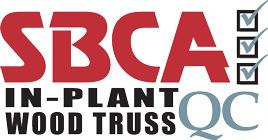 QUALITY Speaks for Itself
QUALITY Speaks for Itself
Listed below are Frequently Asked Questions (FAQs) about SBCA In-Plant Wood Truss QC and SBCA’s Certification program. If you have any questions that were not addressed above, please contact SBCA staff.
What is SBCA In-Plant Wood Truss QC?
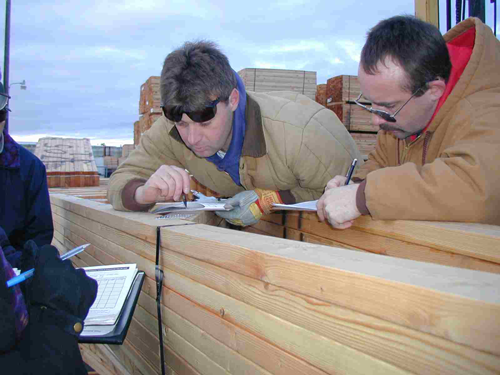 SBCA In-Plant Wood Truss QC is a program that helps component manufacturers monitor the quality of trusses they manufacture. This in-plant program consists of two main parts: 1) inspection procedures and 2) software for storing the results to see trends over time.
SBCA In-Plant Wood Truss QC is a program that helps component manufacturers monitor the quality of trusses they manufacture. This in-plant program consists of two main parts: 1) inspection procedures and 2) software for storing the results to see trends over time.
Inspection
The new web version has one inspection with four parts:
- Inspection Information: Stores information about the inspection, including Job number, Truss ID, Truss Type, Date/Time, Line, Shift, Crew, and Fabrication Tolerance.
- Preliminary Truss Inspection: Verifies that the lumber and truss dimensions correspond to the design.
- Joints and Members: Verifies that the plate is placed within a certain placement tolerance specific for each joint. Checks are made on plate embedment, member-to-member gaps and lumber defects. If necessary, connector plate teeth are counted to determine if the number of teeth required to be in members is actually present.
- Truss Dimensions: This optional section makes it possible to track additional truss dimensions not outlined in ANSI/TPI 1.
Software
The data from the completed inspections is entered into the SBCA In-Plant Wood Truss QC website. Storage of the data allows users to see their performance over time in graphs, and to find out more detailed information on performance by crew, truss type, etc. You can use any laptop or tablet with an internet connection. We plan to develop a phone interface in the future.
Why was SBCA In-Plant Wood Truss QC developed?
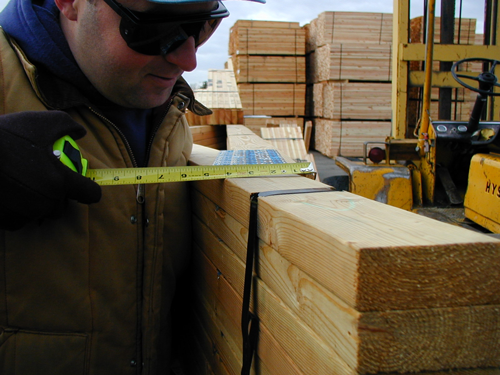 SBCA developed this program at the request of its members, who wanted a way to monitor the quality of their manufacturing process. SBCA In-Plant Wood Truss QC allows users to create detailed charts and reports, so they can review their quality, and observe how that quality changes over time. SBCA members also had concerns that the inspection procedures being used by inspection agencies were not always consistent. Thus, SBCA created this program to be very objective, with little room for variation between inspectors.
SBCA developed this program at the request of its members, who wanted a way to monitor the quality of their manufacturing process. SBCA In-Plant Wood Truss QC allows users to create detailed charts and reports, so they can review their quality, and observe how that quality changes over time. SBCA members also had concerns that the inspection procedures being used by inspection agencies were not always consistent. Thus, SBCA created this program to be very objective, with little room for variation between inspectors.
What is the intent of the SBCA In-Plant Wood Truss QC Program?
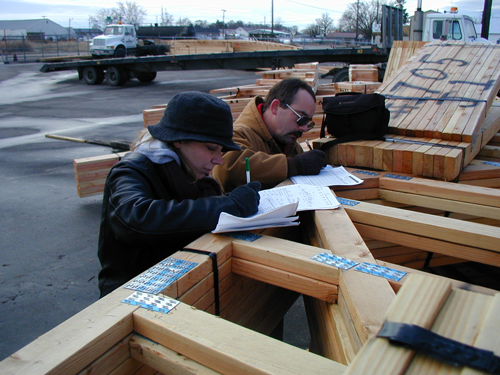 The intent of the SBCA In-Plant Wood Truss QC program is to provide an objective, quantifiable method of assessing a truss manufacturer’s conformance to the latest edition of ANSI/TPI 1, National Design Standard for Metal Plate Connected Wood Truss Construction. This is the wood truss industry’s current standard. If a company has trusses that pass inspection, then the areas inspected are also in alignment with ANSI/TPI 1. This standard is what the ANSI consensus process created and was approved as the quality requirements for all component manufacturers in this country. In addition, the ANSI/TPI 1 standard is referenced by the International Building Code (IBC) and the International Residential Code (IRC). SBCA’s role in this is to provide a method to accurately assess conformance to the ANSI/TPI 1 standard. SBCA used the quality records gathered over time to create a database of information that was used to modify the ANSI/TPI 1 standard such that the consensus process would take into account, as well as possible, inside manufacturing realities.
The intent of the SBCA In-Plant Wood Truss QC program is to provide an objective, quantifiable method of assessing a truss manufacturer’s conformance to the latest edition of ANSI/TPI 1, National Design Standard for Metal Plate Connected Wood Truss Construction. This is the wood truss industry’s current standard. If a company has trusses that pass inspection, then the areas inspected are also in alignment with ANSI/TPI 1. This standard is what the ANSI consensus process created and was approved as the quality requirements for all component manufacturers in this country. In addition, the ANSI/TPI 1 standard is referenced by the International Building Code (IBC) and the International Residential Code (IRC). SBCA’s role in this is to provide a method to accurately assess conformance to the ANSI/TPI 1 standard. SBCA used the quality records gathered over time to create a database of information that was used to modify the ANSI/TPI 1 standard such that the consensus process would take into account, as well as possible, inside manufacturing realities.
What does “Certification” mean?
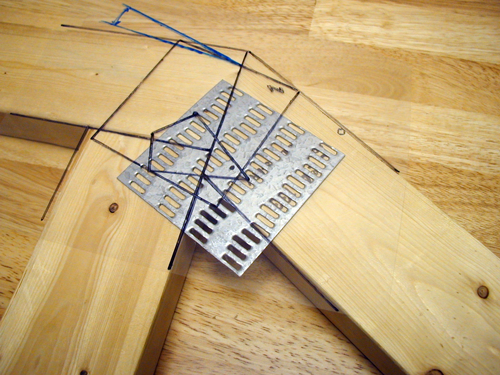 “Certification” in SBCA In-Plant Wood Truss QC means SBCA has trained the component manufacturer in the use of software and in-plant inspection procedures and reviews data submitted quarterly by each plant. SBCA communicates with the plant in order to assist them in attaining a minimum level of quality. Certification in SBCA In-Plant Wood Truss QC complements quality certifications provided by SBCRI’s accredited third-party inspection program.
“Certification” in SBCA In-Plant Wood Truss QC means SBCA has trained the component manufacturer in the use of software and in-plant inspection procedures and reviews data submitted quarterly by each plant. SBCA communicates with the plant in order to assist them in attaining a minimum level of quality. Certification in SBCA In-Plant Wood Truss QC complements quality certifications provided by SBCRI’s accredited third-party inspection program.
What are the benefits of being certified?
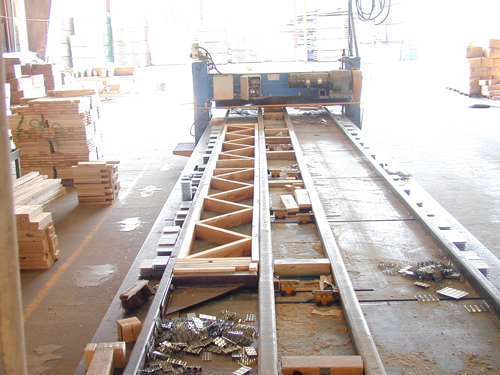 There are both long- and short-term benefits to being certified in SBCA In-Plant Wood Truss QC, which fall into several categories:
There are both long- and short-term benefits to being certified in SBCA In-Plant Wood Truss QC, which fall into several categories:
MONETARY
It is common for companies using SBCA In-Plant Wood Truss QC to experience cost savings due to reduced repairs and call-backs. SBCA’s 2013-14 President, Scott Ward of Southern Components in Shreveport, LA, reported that when comparing the first four months of one year without the SBCA In-Plant Wood Truss QC program to the first four months of the next year using the program, they experienced a cost savings in this area of 65-75 percent.
MARKETING
SBCA is committed to assisting certified companies in their efforts to promote their commitment to quality in their market through the use of SBCA In-Plant Wood Truss QC.
SCORE CERTIFICATION: Certification in SBCA In-Plant Wood Truss QC is a requirement for a plant to earn the designation of SCORE (Structural Component Operations Reaching for Excellence) Certified.
BUSINESS PROTECTION
As stated by Kent Pagel, SBCA’s legal counsel, SBCA In-Plant Wood Truss QC is a key part of component manufacturers’ risk management efforts.
EMPLOYEE TRAINING
SBCA In-Plant Wood Truss QC allows manufacturers to train their employees on what “quality” really means, in objective terms. By using the program, QC inspectors learn in detail the quality requirements and then are able to train staff on the table, which is a very effective way to reduce errors and increase quality.
IMPROVED MORALE AMONG EMPLOYEES
When employees know clearly what is expected of them, and there is a measure they can track, they take more pride in their work.
EXPECTATION OF QUALITY REQUIREMENTS OF CUSTOMERS
The home building industry is moving toward ISO 9000 quality standards. Part of compliance with ISO 9000 is having suppliers that make products to a given quality standard. SBCA In-Plant Wood Truss QC provides the quality foundation to meet the demands of our customers well into the future.
What are the required steps to becoming certified, and maintaining that certification?
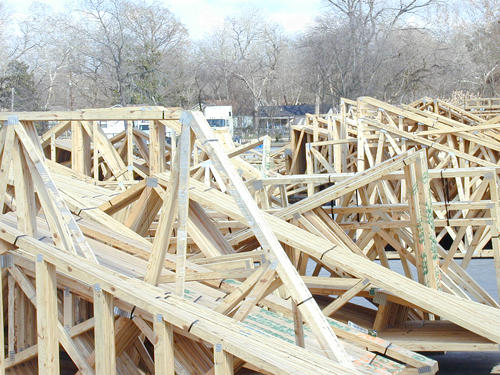 Join SBCA.
Join SBCA.- Purchase a license to SBCA In-Plant Wood Truss QC.
- Use the program for at least two months. This includes doing inspections at the frequency recommended, and entering the data from those inspections into the web site.
- Schedule a visit with an SBCA staff member to come to your plant for the Certification Training or set-up a remote training that is completed through an online meeting. This includes training your personnel in the inspection procedures and software usage. You can discuss the benefits of either face-to-face or remote trainings with SBCA staff.
- Sign and return the Certification Agreement to SBCA.
- After the training, perform inspections at the required frequency and enter the data into the SBCA In-Plant Wood Truss QC software equivalent to one month’s worth of data.
- Inform SBCA when your data is ready for review. We will review your data and provide insight as to how your company can improve in order to meet certification requirements. When data indicates compliance with the ANSI/TPI 1 standard, SBCA can then certify your company.
- Join SBCRI’s third-party inspection program to meet the requirements for quarterly reviews.
Note: The final step in certification is self-certification. It is very important that companies be sure they can maintain the requirements of certification before completing their certification process. SBCA recommends to certifying companies that they continue doing inspections at the required frequency for at LEAST one month before stating they have completed certification.
It is not necessary that the steps to certification be done in the order outlined, although this order is recommended. It is possible for the certification inspection to be combined with a training session of plant personnel on its use first, and compilation of the one month of data to follow.
After successful certification in the program, you will then be eligible to use the SBCA In-Plant Wood Truss QC logo for custom truss ink stamps and promotional brochures. These materials remain the permanent property of SBCA, and are licensed to the truss manufacturer for their use as long as they remain certified in good standing.
What happens if a certified company does not maintain all requirements after certification?
Companies who, after certification, cannot maintain the requirements listed in the manual will be placed on probation, and later decertified. This is why SBCA recommends that companies be confident they can execute the program at the required inspection frequency for at least one month before completing their certification, and preferably during the busiest part of the year.
How long does it take to become certified?
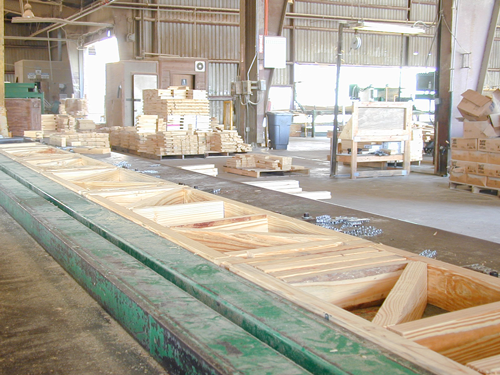 The time to complete the certification process is up to the individual company, and SBCA has no time requirements. The minimum possible time would be two months; most companies take longer. It all depends upon how quickly the company embraces the SBCA In-Plant Wood Truss QC procedures, how much time is invested in the program, and how much the program is supported by upper management. In SBCA’s experience, those companies who commit to using SBCA In-Plant Wood Truss QC and invest the time can become certified in less than six months.
The time to complete the certification process is up to the individual company, and SBCA has no time requirements. The minimum possible time would be two months; most companies take longer. It all depends upon how quickly the company embraces the SBCA In-Plant Wood Truss QC procedures, how much time is invested in the program, and how much the program is supported by upper management. In SBCA’s experience, those companies who commit to using SBCA In-Plant Wood Truss QC and invest the time can become certified in less than six months.
Who in our plant should do the inspections?
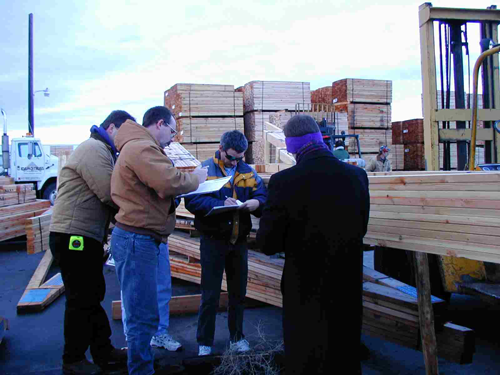 Anyone within the plant can do inspections. It is not necessary that the individual(s) have experience in manufacturing. Someone who has never before seen a truss can be trained within one day to understand all inspection procedures.
Anyone within the plant can do inspections. It is not necessary that the individual(s) have experience in manufacturing. Someone who has never before seen a truss can be trained within one day to understand all inspection procedures.
SBCA does recommend, however, that care be taken in selecting the individual(s). While inspection procedures are not highly technical, they do require the ability to do simple math, read design drawings and required teeth reports, and take measurements.
Further, SBCA recommends that the individual(s) doing inspections not be directly supervised by production. This creates a conflict of interest, and SBCA has seen cases of the success of the program being limited due to this situation.
It is very important that companies train more than one inspector! While certification belongs to a location, it is really the individuals trained who carry the knowledge of the program. The greater the number of trained inspectors you have, the more you will be able to have continuity in the certification program and coverage as necessary.
An excellent choice for an inspector is a crew member who has been injured on the job and is restricted to light duty. QC inspection may allow an early return to work due to it being a low-impact job, yet one that has great value to the company and allows the employee to stay involved with day-to-day company activities until s/he can perform their job again.
What about data entry?
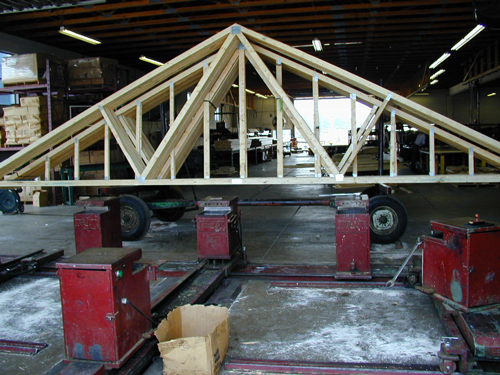 The SBCA In-Plant Wood Truss QC program has recently been updated to allow data entry through the Internet. If a laptop, tablet or other device is used during the inspection, paper forms can be eliminated and when used in conjunction with software integrated with the truss design, the amount of data entry is significantly reduced. We plan to develop a phone app in the future.
The SBCA In-Plant Wood Truss QC program has recently been updated to allow data entry through the Internet. If a laptop, tablet or other device is used during the inspection, paper forms can be eliminated and when used in conjunction with software integrated with the truss design, the amount of data entry is significantly reduced. We plan to develop a phone app in the future.
What Inspection Sections are Required for Certification?
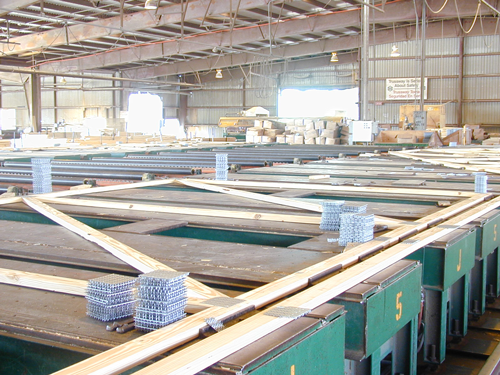 Trusses can be designed with different fabrication tolerances. The selected fabrication tolerance affects the allowable tolerances in the inspection. The Preliminary Check Inspection is required to scan the overall quality of the truss. The Joints and Members section is required to rigorously check the critical joints of the truss. The Dimensions section is not required for certification in SBCA QC In-Plant Wood Truss. The Dimensions Inspection was created such that truss plants could track additional dimensions not outlined in Chapter 3 of ANSI/TPI 1.
Trusses can be designed with different fabrication tolerances. The selected fabrication tolerance affects the allowable tolerances in the inspection. The Preliminary Check Inspection is required to scan the overall quality of the truss. The Joints and Members section is required to rigorously check the critical joints of the truss. The Dimensions section is not required for certification in SBCA QC In-Plant Wood Truss. The Dimensions Inspection was created such that truss plants could track additional dimensions not outlined in Chapter 3 of ANSI/TPI 1.
SBCA QC is an integral part of SCORE certification, along with Truss Technician Training, In-Plant Safety and sending Jobsite Packages. One key benefit of SCORE certification is that the SCORE subscription price bundles various industry best practice programs, including the ongoing costs associated with SBCA QC certification.
How does SCORE Certification fit in with SBCA QC Certification?
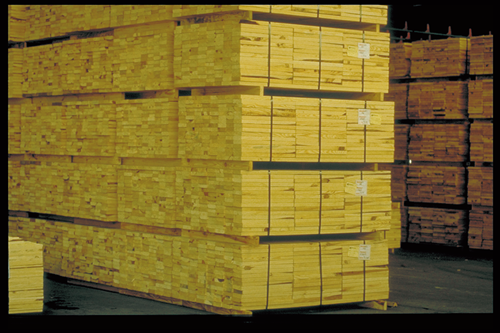 SBCA QC is an integral part of SCORE certification, along with Truss Technician Training, In-Plant Safety and sending Jobsite Packages. One key benefit of SCORE certification is that the SCORE subscription price bundles various industry best practice programs, including the ongoing costs associated with SBCA QC certification.
SBCA QC is an integral part of SCORE certification, along with Truss Technician Training, In-Plant Safety and sending Jobsite Packages. One key benefit of SCORE certification is that the SCORE subscription price bundles various industry best practice programs, including the ongoing costs associated with SBCA QC certification.
SBCA In-Plant Wood Truss QC Certified Component manufacturers are Dedicated to Building Quality.
SBCA In-Plant Wood Truss QC is a powerful inspection procedure for component manufacturers. Becoming a certified user of SBCA In-Plant Wood Truss QC means that the manufacturer has made a commitment to excellence and can consistently produce quality-built trusses. This manufacturer has devoted considerable resources in implementation and now has the information to ensure its product meets current industry standards.
The end result is a commitment to manufacturing quality trusses and increasing the quality of the finished structure.
If you have any questions that were not addressed above, please contact SBCA at 608-274-4849.




